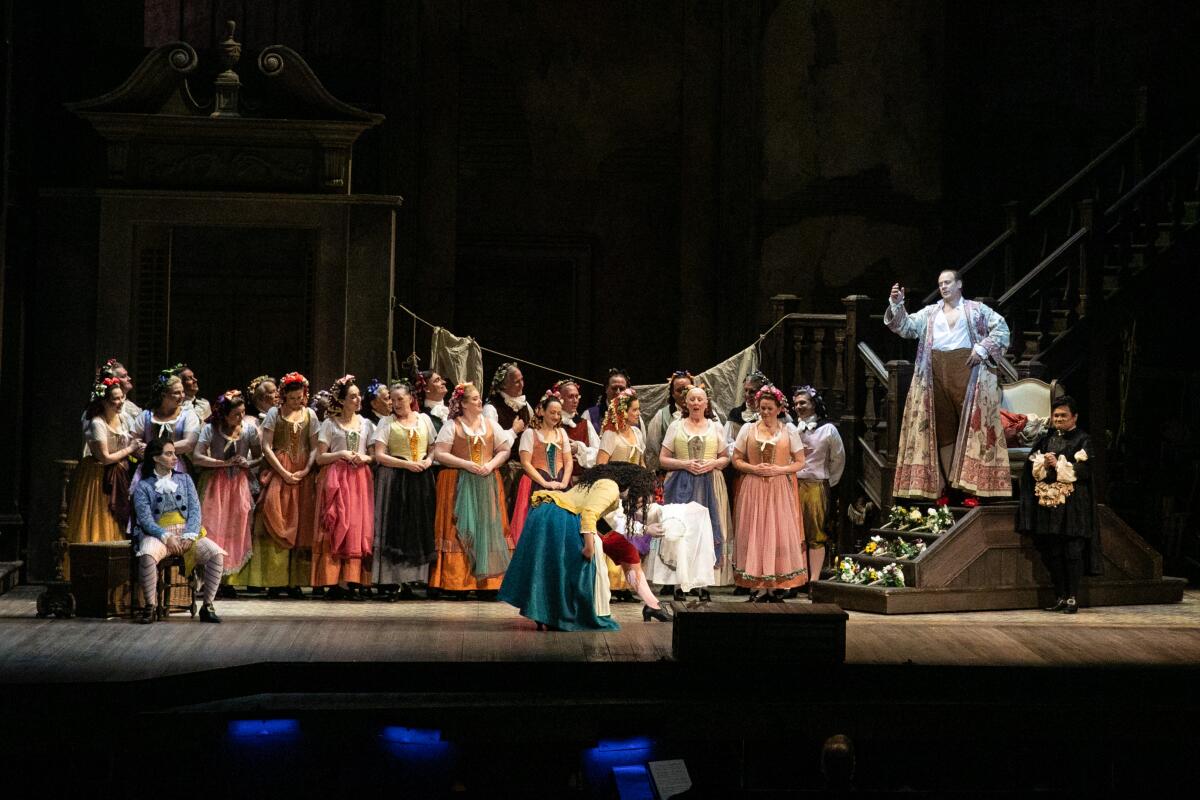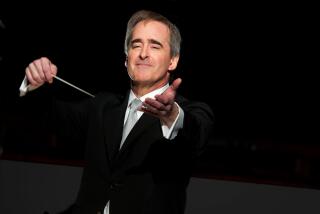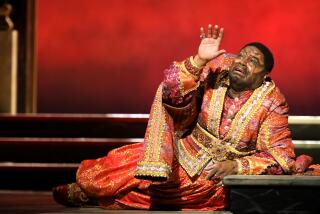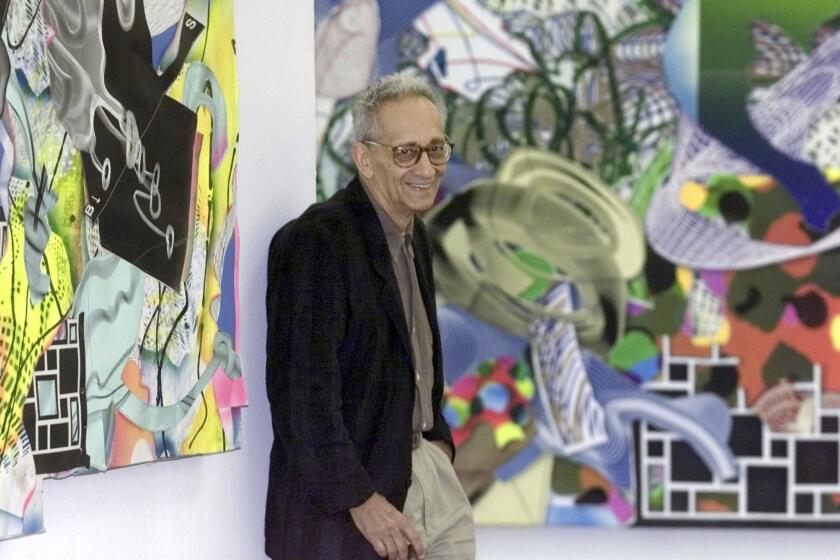Review: James Gray’s traditional ‘Marriage of Figaro’ at L.A. Opera is not what it seems

A hokey, old-fashioned painted curtain covering the Dorothy Chandler Pavilion stage was not an encouraging first sight. The vivacious overture conducted with grace and fluidity did, on the other hand, provide reason for hope. But with the rise of said tired curtain revealing an uninspired period set and costumes, as well as singers seemingly instructed to repress the fact that the Earth has continued turning since 1786 was, once more, cause for concern. Los Angeles Opera’s new production of “The Marriage of Figaro” had more than three hours yet to go Saturday night.
Mozart treats social class, gender and sexual issues in his opera with an enlightened awareness that has only grown more relevant in ensuing generations. The composer all but demands that a modern audience measure its own time and attitudes against those he wishfully proposes in “Figaro.” But if the opera is turned into an irrelevant period drama of yore, can even Mozart’s sublime music pull us through? Given how theater dates as quickly as fashion, who’s going to stick this one out?
The answer to the first question is yes. The answer to the second question is that it looked to be a full house at the beginning, and it looked to be a full house at the end. The only difference was that everyone was seated and hushed at 8 p.m., while all were on their feet vociferously cheering well after 11.
“I love it,” a woman loudly exclaimed to everyone in earshot as she headed out of the theater. “I loved everything! I loved the music. I loved the singers!” People around me smiled approvingly. Then again, people seated around me had all night applauded arias with gusto and returned from intermission sharing their enthusiastic eagerness for more.
Opera gets under one’s skin in mysterious ways. Somehow, the popular and musical filmmaker, James Gray — known for “The Immigrant,” “Armageddon Time” and “The Lost City of Z” — found his surprising way under the skin with “Figaro” (his first attempt at directing opera), albeit through unfashionable retrogression.
Since its earliest days film has allied itself, in one way or another, with opera. Silent films were curiously made of operas. Film directors have long tried their hands with opera, although only a minority — Luchino Visconti, Ingmar Bergman, Peter Greenaway and Terry Gilliam among them — have succeeded in bringing their fully recognizable cinematic style to the lyric stage.
In the end, the differences between opera in the theater and on the screen remain significant. The streamed performance of live opera that pervades our media is essentially a document, not film. David Lynch, after being repeatedly pestered by the Salzburg Festival to stage Berg’s “Lulu” — a potentially brilliant match — turned down the offer, because he couldn’t work in such a way that would involve him being beholden to the musical score.
Gray has gone further in his attempted conventional faithfulness to Mozart’s score, and the goings on in Lorenzo Da Ponte’s libretto, more than any respectable modern opera director would dare. It is simply impossible to go back to Mozart’s times in a modern opera house (the Chandler is a good three times larger than the theaters of Mozart’s day) with modern acoustics (not so hot in the Chandler), modern singers — and modern audiences, who arrive on modern conveniences and consume modern refreshments at intermission, while pulling out modern cellphones and sporting modern fashion. The L.A. Opera Orchestra played on modern instruments, with the exception of a fortepiano, but it needed modern amplification.
The result is not an anachronism so much as a studied anachronism. The dreary sets by Santo Loquasto and costumes by Christian Lacroix mimic rather than reproduce the look of the 18th century. The effect is neither supposed cinematic realism nor anything that resembled the 18th century stage. It felt as though Gray had decided that if he is going to contend with the built-in obstacles of staging opera, he would go all the way and tie his directorial hands behind his back.
Yet that extreme proposition may have been the secret to his success. “Figaro” comes as close to being a perfect opera as any in the repertory. No opera before it had presented characters of such depth nor had so overtly proposed social change. The music drives, again as none before had in opera, both narrative and the psychological reasons behind it.
Part of Gray’s challenge was, then, to make characters who luxuriate in or aspire to drab luxury come alive. Their preposterous garb is meant to reveal what they are rather than who they are. Another part of his success was his ability to negotiate intricate stage business in an opera in which the action can become so complicated that almost nobody can follow it. The great message in Mozart’s opera is that the people matter more than their actions.
The audience‘s enthusiastic reaction proved an accurate gauge of the production’s rare narrative clarity. Presumably, Gray’s Hollywood celebrity attracted many new audience members to the opera for last Saturday night’s premiere. There was delighted laughter of those surprised by humorous turns that rarely get a titter anymore. Gray kept everyone in our seats in part because he made you want to know what happens next, whether you did or didn’t.
As he had promised in interviews, Gray does trust the music. Opera has long found subtly understated ways into his film soundtracks. Fragments of “Figaro,” played on guitar, lend moving atmosphere to Gray’s new feature film, “Armageddon Time.” His 10 choices for the Sight and Sound poll of the greatest films of all time are all by directors who used music with superb originality.

Unappealing as the “Figaro” sets may be — and they weren’t necessarily made for the Chandler (the production had its premiere in the Théâtre des Champs-Elysées in Paris where it seems to have impressed hardly anyone — though they do a very good job acoustically of reinforcing voices.) The singers at Saturday’s L.A. Opera showing came already equipped with big voices and were physically commanding as well.
Craig Colclough, a commanding Figaro with a boisterous baritone, was less playful than usual but not unfunny. The excellent soprano Janai Brugger made a substantial Susanna, capable of outwitting Figaro and, more importantly, the Count’s advances. She is the one character who doesn’t change and doesn’t need to.
The Count and Countess, boldly sung by Lucas Meachem and Ana María Martínez, respectively, magnified modern anger and distress under their wigs and ruffles, hard earning our sympathy. A newcomer to L.A. Opera, Rihab Chaieb came close to stealing the show with the way she embodied Cherubino with boyish bumptiousness and a robust mezzo-soprano.
Gray treated the characters in Count’s orbit — Marie McLaughlin (Marcellina), Kristinn Sigmundsson (Doctor Bartolo), Rodell Aure Rosel (Don Basilio), Deepa Johnny (Barbarina), Alan Williams (Antonio) and Anthony León (Don Curzio) — conventionally. They often laid the slapstick on heavily, having little choice if they wanted to make whoever was hiding behind those heavy costumes come to life. But their voices still conveyed character.
Ultimately, it may have been the company’s music director, James Conlon, who was most necessary in making sure there would be the kind of music that needed trusting. He moved things along quickly, surely and suavely.
The real theme of “The Marriage of Figaro” is redemption, the idea that people can change. In 1988, Peter Sellars staged the opera in Trump Tower, suggesting that even a budding, self-important tycoon had in him the power of redemption. Today, we no longer talk about redemption. Our divisions insist that either Trump is fine the way he is or that he is utterly incapable of redemption.
The greatest moment in “Figaro,” and one of the greatest in all opera, is at the end when the Count seeks and gets redemption. Conlon slowed down and awakened an exceptional sensation of new warmth in the orchestra. Magically, everything mattered. The awful costumes, the awful set, the dreary anachronisms melted away. Artifice could be seen through. Idealism had its fleeting moment. If we can only change our minds, it needn’t be Armageddon time just yet.
'The Marriage of Figaro'
Where: Dorothy Chandler Pavilion, 135 N. Grand Ave., Los Angeles
When: Through Feb. 26. Check website for dates and times.
Pricing: $29-$424
Running time: approximately 3 hours and 45 minutes, including one intermission. Sung in Italian with English subtitles.
Contact: laopera.org/, (213) 972.8001
More to Read
The biggest entertainment stories
Get our big stories about Hollywood, film, television, music, arts, culture and more right in your inbox as soon as they publish.
You may occasionally receive promotional content from the Los Angeles Times.







